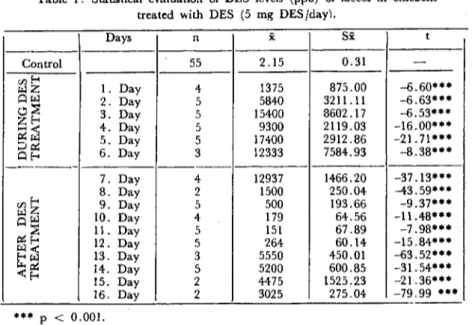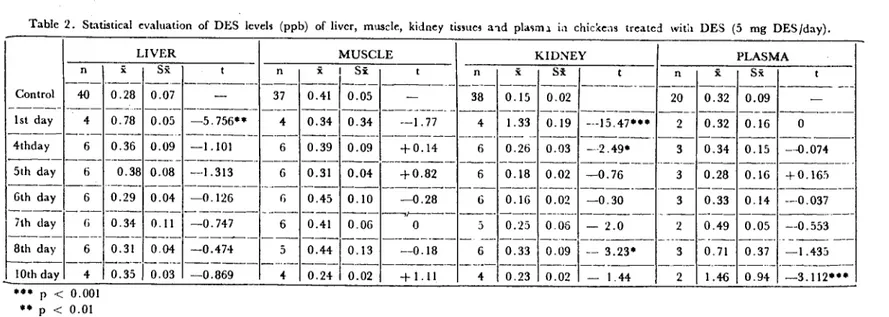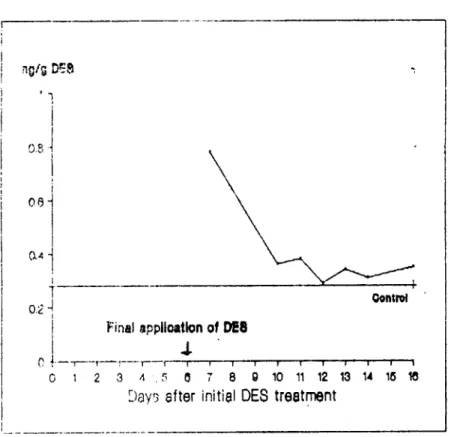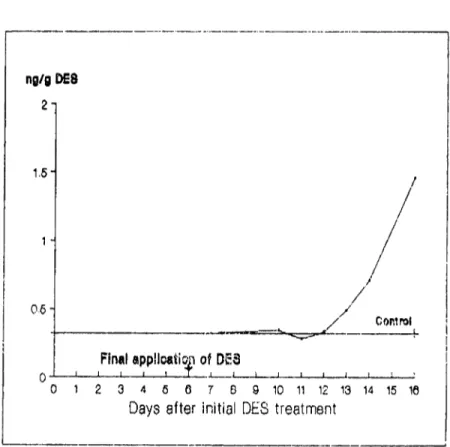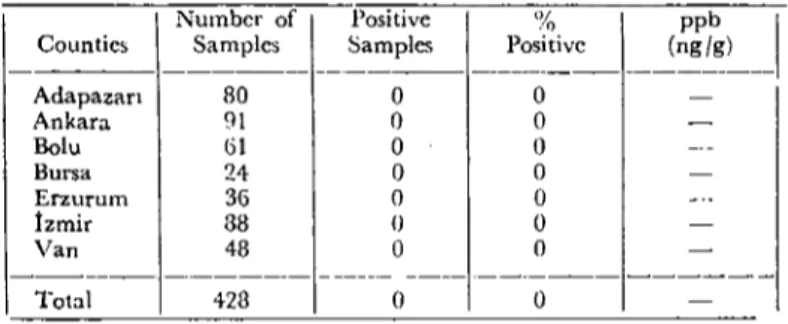A. O. Vet. Fak. Derf1.
39 (L-2): 2\5-231, \992
THE DETERMINATION OF DIETHYLSTILIJESTROL (DES) IN THE FAECES AND TlSSUES OF CIDCKENS TREATEı> WİTH DES AND IN THE FAECES AND
TISSUE SAMPLES OF CALVES, LAMBS AND CHICKENS COLLECTED FROM VARIOUS AREAS OF TURKEY.
Ethem Ersoy!
Tevhide Sel3
oıar Agthe2 Hilal Ergun1
Tayfun Güldür3
DiethylstUbestrol (DES) verUen tavuklann doku ve dışkılannda ve Türkiye'Din çeşitU bölgelerinden toplaaan tavuk, kuzu ve dana doku nUJDUDelerindeve
dış-kılannda DES tayini.
Özet: Yedigün süreyle Gral olarak 5 mg DES Igün verilen 20 deney ve 20 kontrol broilerlerin dıikı, kas, karaciğer ve böbrek dokulamıda DES !lTUllizleri yapıldı. Numuneler radioimmunoars~l' metodu.)'lo analiz edildi. Dokulardan DES'in atılmu süresi tesbit edildi. DES'in son u]gulanmasl1ldan 5 gün sonra dışkıdaki konJantrı2,~J'()71UISI p./Jb alarak iulundu. Bununla be-raber, son verilmeden 7 gün sOTlra DES konsantras.yonu tekrar ,yükseldi, Son DES u}'gulamasırıdan ronra ilk gütı karaciğer, kas ve bıbrekteki DES konsant. rflJ.yonu sırasıyla 0.78, O. 74 ve 1.33 ppb iken denemenin sonunda 0.35, 0.24 ve0,22 ppb olarak bulund/t. Son gün de,ğerleri kontrol değerleri sınırları ifersindedir. Denemenin sonunda pla<.mada ki DES konsantrasyonunda bir artış gözlenmiştir.
Türkiye'ninçeşitli bölgelerindeıı toplanmış dana, kuzu ve piliflere ait kas, karaciğer, böbrek, dışkı ve yem numunelerinde toplam 18]] numunenin DES yönünden ar.aliz/eri.yapılmıştır. Piliç yem numunelerinde
%)
36.9 DES pozitif bulunmuştur. Piliç dışkı numunelerinde de % 1.9 po;;.itif numune tesbit edil-miştir. Diğer numunelerde DES bulunamamıştır.• This study was carried out as part of the scientific link between Ankara University Facu1ty of Veterinary Medicine and Honnover Veterinary highschool and was supperted by the: BMZ - GTZ and the Ankara University Research Fund.
i Prof. Dr. Ankara University, Veterinary Facu1ty, Biochemistry Department, An-kara.
2 Prof. Dr. Fachhochschule Wilhelmshaven, West Germany.
216 Eo ERSOY, O. AGTHE, H. ERGUN, T. SEL, T. GÜLDÜR
Summary: DietllJ-lstiibestrol (DES) arw[vses wae earried out on muscle, lher, kidne;' and faeees samples
~L
20 control and 20 experimentai broi!ers to whieh 5 mg DES jday had been given oraily for a period of 7 days. The treated samples were ana!)'Sed ıısing the Radioimmu1iOassa..J'metlzod. The removal time ~f DES from the tiSSl/es was determined. Five da)'s following the jinaladmi,!istration of DES, İtçfaceJ,! ceneentration was ]51ppb. However 7 doys af ter the fina iadministratioıı laeeal DES eoneentrations inereased again. On the first day ajter the finel DES administration, DES eoneentrations in the lfvcr, musr:le and kidll~v werc 0.78, O. H and 1.3') ppb mpeetiuely. ırhile these ı'aiuer measured on thefinal da,)'were ,dthin the ralZge~f tlze (ontrol values.There mas an inerease ofDFS in plasnıa at the end of the fixperimental peri'Jd. A total of 1811 musele, liver, kidn~y and/aeees samples oj ealves, lambs and r:hickenr and feed samples eolleeted from ut!.rious areas in Turkey were ana!)'sed for the presence of DES positive samples for ehieken feed was 36.9
%.
Alsa 1.9%
ol the ehieken .laeees sanıples ,I'ere DES positive. All other samjJleı u;ere Jlr,2,atiu~for DES.Introduction
Diethylstilbestrol (DES) is a non-steroid synthetie, exogenous
anabolie substanec (5,10,21,23,27,29). it has been used for many
years <,.sa growth promoter in poultry, eattle and lambs by addition to the feed, injeetion or implantation (5,10,11,16,21,21',26). It affeets
feeding effieieney and growth rate ,when used at 5-29
%
(ı 7,24).This effcet is produeed by DES stimulating the produetion of Growth hormone, Insulin and Insuline likc Growth Faetor i (IGF-l) (22,23, 24,31).
Endogenous oestrogcns, when givcn oraJly are largely metaboli-zed during their first passage through the liver. DES, on the other hand is resistant to hepatic mctabolism and when administered oraliy shows high oestrogenie activity (26,29). It is effeetive for a long period
due to the enterohepatie eirculation during its metabolism (15,20, 27,29,30) .
The eliminatian of DES from the body occıırs primarily by way of the faeces where residues are detceteel at the highest lcve! and for the longest period. Thereforc it has beeaınc important to screen for I)ES. _, resı. lics ın t ıe ıacccs'cl .. 1.£' .'(1°22')9\,~, '_'."
THE DETERMINATION OF DIETHYSTILBESTROL (DES) 21i
Becausc of its casy aclıninistration and bcing the cheapest oestro-genic substancc (21,29), DES is usecl according to the indication li-mits for treatment in human medicine (prostate cancer, breast cancer, osteoporasis ete.) (8,18,26,28) and veterinary medicine (pyometra,
vaginitjs, anoestrus, prostate hypcrtrophy ete.) in smaIl animals
(26,27) .
DES was first usecl for anabolic purposes in cIıickcns in J 9ı7 but its use in thcsc animals \vas prohibited in 1959 (7,19,26,32). It was first used in eatde in 195", ancl \Vas used in the U.S.A. as an ana-bolic substanee by addition to fecd until 1979 (23,26,32).
In Gennany the percentage of DES positive samples rase from
4.
%
in i977 to lG%
in i978 and 40%
in 1979. After the c1iseovery of DES in babyfood~; strict controls with sensitiye methods wereint-rodueed the result bcing a drop in DFS-positive samples to 1
%
in1980 (3,22).
Several methods have been developed for the quantitative and
qua1itative determination of DES in matcrials of animal origin. In
routine use, Radioimmunoassay (RIA) has proven to be the most
sensitiye and eheapest method for the fast deteetion of residue !eve!
in the nanogram and even picagram range in large series of
samp-les (21).
vVith the introduction of sensıtıve teehniques, DES residues
\'Yere deteeted in tissue samples. The discovery of the teratogenic and carcinogenie effeets of DES and other stilbene derivativcs led to the prohibition of their use in animals used for foad prodııetion in the
USA and the EC countries (5,26,32). In EC countrıcs produetion and
marketing of DES are alsa prohibited (26, 32). Although the use of
DES in the USA and EC countries has becn prohibited for rood
pro-ducing animals, it is suspeeted that DES is bcing used secretly and illegally as an anabolic agent (3, 5, 21, 22, 23). Recently traee
amo-unts of DES in meat exparted to the USA from Germany have been
diseovered and reported upon (3).
In the EC countries the presence CJ illegal anabolie substances in live animal~ used for foo d produetion is monitored for in t.heir urine or faeees and in tissue samplcs arter slaughter using sensitiye methods regularly (22). Howcvcr thcrc is no information regarding DES analy-ses İn Turkey.
218 E. ERSOY, O. AGTHE, H. ERGUN, T. SEL, T. GÜLDÜR
The use of hormone and antihormone prcparations as [ood
additives in Turkey is prohibited by law (4), But in veterinary medi-cine DES is being used as orstrogcn preparation for treatment in food produring animals.
Thcreforr, the first aim of the study was to determine the remo-val time of DES from the various tissues of trcated ehiekens and its
deteetion limit by RIA,
Secondly the presenCl~ of DES in mcat exportcd froın or impor-ted into Turkeyand also the use of DES as anabalic substance in
Tur-key were monitored.
Material and Method Materials
a) Eqııipmen!
Rack Beta Liquid scintillation count!'r 1211 jl2l2 Instruınent
Manuel (LKB), Vacuum Drying o,'en (Heraeus) Centrifuge at 6000
rpm with cooling system (Heraeus), Magneıic stirrer (Janke and
Kunkd, IKA labortechnik). b) Chemicals
'All chemicals used were analytical grade. Gelatine, Sodium
azi-de (Natriumazid), Titriplcx III, NaCl, NaOH,
di-natriumhydro-genphosphatc dihydrat, Kaliumdihydrogenphosphate, Ch lorufarm ,
Ethanol, Dil"thylether and Methana! were obtained from Merck
ehemical company, Dextran l' 70 ,vas obtained from GmbH Co.
Chem. Fabrik, Norit-A was obt:üıied from Serva chemical company, Diethylstibestrol was oLtained from Sigma ehemical eomlJany.
DES Antibody ,vas kincily provided by Prof. Dr. H. Karg, Insti.
tut für Physialogie der südd. Versuch. und Forsehungsantalt für
Mikh Wirtschaft Weinhenstephen-Münehen. (MonoethyPH) DES
(250 u Ci/ml) was obtained from Amershan International pk.
Eng-land. ScintiUarion coctails were obtained from J.T. Baker Company.
Experimmıal Procedure
The study was performed in two parts; as an experiment and as
THE DETERMINATION OF DIETHYSTIlBESTROl (DES) 219
A) In the experiment; 40 broilcr chickens eight weeks old were
used, 20 of these chickens were kept as controls, the other 20 broilers
were treated with 5 mg/ml in ethanol DES per day givcn orally.
These chickens were treated with DES for 7 days. iml vf ethanol was
administered to controls during DES adminis~ration period. The
experiment was continued for 16 days and ehiekens were slaughtered at intervals from day 7 to day 16. Faeces samples were collected be-fore DES administration and on days ito 16 following DES adminİst-ration. Following slaughtcr plasma, Iiver, kidney and muscle tissues were collectcd and analysed by RIA for DES. Chickens were
allo-wed free access to food and water throughout the experiment and
plaeed in seperate cages.
LL)For the monitoring; 1Jusdc, liver, kidney and faeces samples of lambs, chiekens and calves were coııeeted from slaughter-houses; f<ı.eeesand feed samples were eollceted from 50 farms. The samples were kept at ._.20°C. A total of 926 faeces samples (260 ehieken, 238 Iamb and 428 ealf) were analysed for DES. DES analyses were also earried out on 245 ehieken muscle, 220 chicken kidney, 181 chieken liver,
44 calf muscle and 195 feed samples.
Method
DES concentrations in muscle, liver and kidney tİssues in feed
and faeees samples were determİned using the technİgue of
Radioim-munoassay (RIA) (1,2). In brief, free DES obtained by diethylether
extraction and various solven t-solvent partition steps was measured
by RIA using radioactive DES and DES antibody. DES standards
ranging from 12.5-800 pg /0.iml were prepared from a stoek solution of DES in ethanol at a eoncentration of 800 mg ImI, the stoek solution
being prepared from i mg DES
ımı
ethanoI. Results were obtainedwith the lise of the standart curve. Statistical Analysis
The significant differences between values obtained from the
DES analyses was determined using the student "t" test (13).
Results
In the experimental study, DES concentrations in faeees samples
eollected after DES administratİon were found to be significan tly
high (P
<
0.001) during the 16 days of the experimental periodcon-220 E. ERSOY, O. AGTHE, H. ERGUN, T. SEL, T. GÜLDÜR
Table 1. Stati.ı;tiea1eva1uation of DES 1evels (ppb) of faeees İn ebickem treated with DES (5 mg DES/day).
Days n x Sx t -o Control 55 2.15 0.31
-cJ)f-< 1. Day 1375 875.00 -6.60." r.ıZ 4 elr.ı 2. Day 5 5840 321ı.II -6.63". O~ 3. Day 5 15400 8602.17 -6.53". Zf-< •..•< 4. Day 5 9300 2119.03 -16.00." ~r.ı 5. Day 5 17400 2912.86 -21.71 ••• ~~ elf-< 6. Day 3 12333 7584.93 -8.38". --7. Day 4 12937 1466.20 -37.13 ••• 8. Day 2 1500 250.04 --43.59". cJ)f-< 9. Day 5 500 193.66 -9.37 ••• r.ıZ elr.ı 10. Day 4 179 64.56 -11.48 ••• ~ ll. Day 5 151 67.89 -7.98". ~f-< 12. Day 5 264 60.14 -15.84". r.ı< tr.ı 13. Day 3 5550 450.01 -63.52 ••• <~ 14. Day 5 5200 600.85 -31.54 ••• 15. Day 2 4475 1525.23 -21.36 ••• 16. Day 2 3025 275.04 -79.99 ••• -••• p < 0.001.centration of this substance in the faeces was 1375 ppb (P
<
0.001).On the fifth day of DES administration the faecal concentration of
this anabolic agent reached its highest level during the cxperimental period, 17.400 ppb (p
<
0.001). From the 8 th day of the experi-ment, 2 days after the final administration of DES, faecaI DES con-centrations dropped dramaticaUy to a minimum of 151 ppb on the II th day, rising to a second maximum of 5550 ppb on day 13. On the final day of the experiment (day 16), faecal DES concentrations began to decrease once more with a value of 3025 ppb (Figure 1). The mean value for the control group not given DES was 2. 152 ppb (Table 1).One day following the final DES adminisrration DES concentrations
in the liver. (Table 2 and Figure 2) and kidney (Table 2 and Figure 3) were found to be significantly high (p
<
0.001). A1though during thefollowing days no significant amounts of DES were detected in the
liver, in the kidney DES residues rose on day 4 (P
<
0.05) and day b foUowing the final DES administration (p<
0.01). One day follo-wing the final DES administration, DES concentrations in the muscle samples were 0,738 ppb though this value was not significantly higher than the control value of 0.4 10 ppb when analysed statistically (Tab-le 2, Figure 4). Plasma DES (Tab-levels remained near the control value between days 7 and 13 of the experiment (i.e. 1 to 7 days after thefi-THE DETERMINATION OF DlETHYSTILBESTROL(DES) l!21 ng/g DES 10000
(\
i \i \
J \,
\
\ \T
FI_bU ~1I •• 1••• i ir
J
f ij
! 5000 o Ci~
I'"~
ii
~ 1 2 3 4 -5 6 7 8 9 10 11 12 13 14 15 L~Days after initial DES treatment
Figure I, Excretion of DES in faeces of chickens arter oral application of 5 mg DES Iday for a 7 day period,
nal administration of DES) inereasing to 1.46 ppb (P
<
0.01) onday 16 (Figure 5). In the control group not administered DES, DES
concentrations in the muscle, liver,kidney and plasma samples were
0.410, 0.278, 0.150 and 0.324 ppb respectively (Table 2). The de-tection limith of DES positive samples using RIA are given in Tab-le 3.
The results of analyses caried out on [aeces, muscle, liver and kidney samples of calves, lambs and chickens and on chicken feed
samples collected from various areas of Turkeyare shown in Tables
4, 5, 6, 7. A total of 195 feed samples were analysed for DES and 36.9
%
of the samples were found to be positive (Table 7). These feedVntersuc-'.
Table 2. Sı:\tisıical cvaluaıion of DES Icvel~ (ppb) of livcr, muscIe, kidney tissuei a"ld pla~mı ıa chickeas treatcd ",ith DES (5 mg DES/day).
LlVER MUSCLE KIDNEY PLASMA
n i Si<. i n x i Si t n x Sx t n x Sx t ---
._--
_.-----_
.._- ---0.4~1~-.O5 .- -_.'- --- --- ---~--- --- -------
---onlrol 40 0.28 0.07_._--_
37 38 0.15 0.02 20 0.32 0.09 ..- ---._---. ----
----,---t day 4 0.78 0.05 -5.756" 4 0.34 0.34 --1.77 4 1.33 0.19 ---15.47••• 2 0.32 0.16 O -- ---- ---_._.------- ---
----.---
---._.-
.._-_.- _._--
.-- -----
---hday 6 0.36 0.09 -1.101 6 0.39 0.09 +0.14 6 0.26 0.03 ---2.49. 3 0.34 0.15 --0.074 - --- --------
--- ------ --
--- --- -----
--- .._---- --- ___ o .. h day 6 0.38 0.08 --'1.313 6 0.31 0.04 +0.82 6 0.18 0.02 -0.76 3 0.28 0.16 +0.165 - _.-._---
-_.----_._--
._--
---
--- --- ---- --- --- ._------
__ o---h day 6 0.29 0.04 -0.126 rı 0.45 0.10 --0.28 6 O.lG 0.02 -0.30 3 0.33 0.14 ---O.037
---
---
-------
--- ------ ---
----.1-------
---- ----_._-----
._- ---- --- --_._'.---h day (j 0.31- O.LL -0.747 6 0,4~ 0.06 O 5 0.25 0.06 - 2.0 2 0,49 0.05 ---0.553 --- --------
---~----OA~I O~13 ------O~09T-:'-=-3.
23.-_.--- --- ____ o ---h day 6 0.31 0.04 -0.1-74 5 --0.18 6 0.33 3 0.71 0.37 -1,435 ---o~5-To~3---O
:86'9- --.{---
--- ----_
.._
.•. _---ıh day 4 0.24- 0.02 +i.ıı 4- 0.23 0.02 - 1.1-4 2 1.46 0.94- -3.112 ••••
p < 0.001•
P < 0.01•
p < 0.05•
c Is •• 6ı 5ı 4ıTIIE DETERMINATION OF DIETHYSTlLBESTROL (DES) 223
l
Oonlrol\
.
~ ii
i 0.8 .~i
, i 0131
i
(ı41
iT---02l
i
rinal IJpplloatlon of 028i
.J.
()t--,----f-!----r-r-l-~~~-~---~~~-o 1 2 3 J\ .:; O 7 B g ıo ıı 12 13 14 ıt5 1e ~)ay'3 sf ter initiel DES treatmentFigure 2. Rcınoval of DES from thf' liver of slaughtered chickens arter oral iıpplicatiori of 5 mg DES for a 7 day period.
hungsamt and Staatliches Veterinaruntersuehıiıigsamt, Oldenburg)
where this result was confirmed by RIA and GC-MS (I 4). Of the
po-sitiye ehieken feed saınples 59.7 % had a range between ıo-50 PPiJ
23.6 % betwcen 50-100 ppb and 16.7 % abovc 100 ppb DES (Tab-le 7).
In the ehieken faeees samples obtained ftom the eounties of Bolu,
Bursa and Erzurum, the percentage of DES - positive samples was
1.1 %,4.4
%
and 6.5 % respeetively (Tabit" 4). No DES-positivc ealf and lamb faeees samples were found (Table 5 and 6).In the 245 muscle, 220 kidney and 181 liver samples of ehiekens eolleeted by ministry of Health from 29 eountries analysed no - DES
positive samples were faund. Forty - four ealf muscle samples were
ım Eo ERSOY. O. AGTHE. H. ERGüN •.T. SEL; T. GüLDüR ilgi;DEl
._----+
.Control Flnal applloatl 0.2 O.•• 0.8 Oo
2 3 •• ~ 6 7' 8 9ıo ıı
12 13 14 16 16Days af ter Inltial DES treatment
Figure. 3. Removal of DES from the kidney of slaughtered chickens after oralapplication of 5. mg DES for a 7 day period.
. .' Discussion and Conc1usion
DES eauses inereases in body wieght and feeding efficieri~y (6, 7, ll, 16, 17, 24-). Therefore meat produetion inereases, thus the use of DES is eeonomieally viable. However due to its eareinogenic and teratogenie effeets (5, iO, 19, 21, 23, 26, 32) it po ses a risk for die eonsumers. DES is prohibited therefore it must not be found iri any biologieal materials of animal origin .
. In the experiment, on day 8 to 12 it appeared .that DES had be,en removed from the ehieken, however on day 13 there was a further dramatic inerease in the faeeal DES eoneentration (Figure 1)., This may be due to the presenee of metaboHe intermediates of DES such asparaquinone (this being the precursor for the biosynthesis of dienes~ tral), or other DES metabolites such as diem'strol and
w-hydroxydi-THE DETERMINATION OF DIETHYSTrLBESTROL (DES) 225
"gl"DE8
0,6
0,2
Final ıppllcatlon of DES
J.
O
O 234 5 6 T 8 9
ro n ~ m
w ffiw
Days after initiai DES treatment
Figure 4. Removal of DES from the musc1eof slaughtered chickens after oral application of 5 mg DES for a 7 day period.
enestrol which give cross reactions with DES (30) or of free DES,
produced as a result of bacterial action on DES-glucuronide in the
intestine (15, 27, 29). Therefore this apparent increase in faecal DE') after day 13 (Figure 1) can be attributed to the enterohepatic circu-lation of DES and its metabolites, thereby prolonging the effccts of these substances in the organism, as secn by the presence of DES in the kidney on days 7 (p
<
0,001), 10 (p<
0.05) and 14 (p<
0,05)(Figure 3). DES concentrations in the Hver on day 7 was 0.78 ppb,
significantly higher (p
<
0,01) than the control value of 0,278 ppb.Thereafter liver DES concentrations decreased to near the control
value.
The livcr plays an important role in DES metabolism. DES is
226 E. ERSOY, O. AGTHE, H. ERGUN, T. SEL, T. GÜLDÜR ---_._---, ng/g DES 2 Control ! i
/
/
/
/•..
;:;;;:;=' ,/ 1.5 06o
O Flnal appllcatio of DC":S 2 3 4 ii 6 7 8 9 10 11 12 13 14 15 16Days after initial DES treatment
---~
Figurc 5. Rcmoval of DES from the plasma of slaughtered chickens after oral application of 5 mg DES for a 7 day period.
Table 3. Limit of detection of positive samples by RIA. Sample Concentrations Muscle Liver Kidney Faeces Fecd 0.08 - LI ppb 0.08 - 0.68 ppb 0.06 - 0.68 ppb O - LO ppb O - LO ppb
19, 20, 22, 27, 29, 30). Thcrefore aeeumulation oeeurs mainly in the liver and kidneys (20, 22, 30). DES has been deteeted in the livcr 60 days after implantation at a 1evcl of 0,1 ppb (30). DES was eleared very rapidly from the blood, however a furtlu-r inercase in plasma DES eoneentration was obscrved thcreafter (19, 20), whieh is eonsistcnt with our results (Figure 5). DES is found for the longest time and at the
i i
THE DETERMINATION OF DIETHYSTILBESTROL (DES) 227
Table 4. DES
Countics
conccnıratİom ın faeces samples of chickcns collected from various areas of Turkey.
I
Number of Positivei
% ppb___Sampl~ ~ampl,=- __ ~~~~ _ _~~ ig~_ Bolu Bursa Erzurum ızmİr Ankara 90 4G 31 59 34 i 2 2 O O ı.ı 4.4 6.:; O O 20. 1G.5; 42.5 11.3; 53 --- --- --- ---- ---_.-- ---_.
__
._--Totali
260i:;
1.9TabIc 5. DES eoncentratİons Number of Samples Countics Adapazarı Ankara Bolu Bursa Erzurum ızmİr Van 80 91 61 24 36 38 48
İn faec(;s samplcs of calves collected from vanous areas of Turkey. PosİIİve (~Io ppb
i
Samples Posiıive (ng Lg) -_._---- - ---O O -O O -O O --O O -O O ---O O -O O -Total 423 O OTabı e 6. DES corıcenlraıions in faeces samples of lambs colleeted from varioııs areas of Turkey.
ppb (ng/g) O O O O O O oı lo Positİvc Number of
i
Posİıive Sampfes Samplcs ._----_._---~---.---I--- ---62i
O 27 O ;) . O 52 O 50 O 3li O Countics Ankara Bolu Bursa Erzurum İzmir Van Total 238 O OTable 7. DES concenır:ııions in chickcn feed sampfes colleetcd from variolIS arcas of Turkey.
Total Number Pasiıive % ppb i
Counties of Samplcs Samples Pasiıive (ng/g)
---VariolIS areas of 195 72 36.9 *
Turkey.
(Erzurum, Van, An-kara, Bolu)
* Of the posılıve chicken fecd samplcs, 59.7 % had a range bcıwecn 10-50 pph 23.6 % bclweeIl 50-100 ppb and 16. 7 ';t.~above 100ppb DES.
228 E. ERSOY, O. AGTHE, H. ERGUN, T. SEL, T. GÜLDÜR
greatest concentration in the faeces (1, 2, 22). Infact it has been re-ported that DES can be detected in the faeces 3 months after
admi-nistration (22). Because the concentration of DES in the urine and
faeces İs 100-1000 times greater than in the tissues (1, 2, 22), it has become İmportant to ana1yse urine and faeces samples while screen-ing for DES (1, 2, 22). This not only al10ws in vivo detection of DES during feeding and befon slaughter but faeces is also relatively easy
to collect (22).
In the ilIegal use of DES, it is difficu1t to prove its administration since the amount of DES giyen, the period, site and method of appli-eation are not known (9, 22, 24-,27). The age and breed of the animal plus individual differences affect the removal of the drug from the
body (9,27). Therefore samplt's to be collected should be selected
carefully and the analytical method used to detect ilIegal uses of DES must be well developed and sensitİ\"e (21,25). Restrictions alone are not effective. With the aid of sensitive and developed methods for residue screening, the use of these iIIegal substances has decreased
(22).
Chicken faeces samples from various areas of Turkey screened for DES using RIA were faund tc be DES positive with the percentage
ofpositive samples being 1,1 % in Bolu, 4-.4 % in Bursa and 6.5%
in Erzurum, giying a national average of 1.9 %.Of the chicken [eed samples analysed, 36.9 % were found to be DES positive (Table 4-).
Upon the detection of DES positive fecd samp1es from 2 factorics
in Turkey (14-), the Ministry of Health ardered the collection of
chickens from across the country fN analysis in the Department of
Biochemistry, Ankara Üniversity Facu1ty of Veterinary Medicine.
Chickens collected from 29 counties were analyscd for DES and 24-5 muscle, 220 kidney and ISI 1iver samples wcre found to be DES ne-gative.
From the present results (Table 4-and 7), it can be concluded that there is stiU a risk of DES being used in Turkey.
The results obtained can serve as a good basis for the cakulation of the risk of DES use in Turkey but alsa underline the necessity to prevent illega1 use of DES and similar compounds in the future. As a conclusion, the cxpcrİmcntal part of the study wilI provide a basİs for the determination of the detection limit of DES for other
labora-THE DETERMINATION OF DIETHYSTILBESTROL (DES) 229
torİes to be estabIished İn the future where analyses will be carrİed out regular1y. Alsa, the present data should be considered as an indicatar of the serİousness of the matter in Turkey.
Acknowledgement
We would like to thank Prof. Dr. H. Karg of the
München-Weihenstephan Institute for providing the DES antibody.
Referenees
i. Agthe, O. (1980).DiL A,rıweııdung des Radioimmwıoassay für Diiithylstilbestrol auf Kotpro-ben von Mastkalbem. Arch. für Lebensmittelhyg. 31-102.
2. Agthe, O., Frenne de D., Sperveslage, C.M. (1979).Vber diL Verbreiturıg der Adwen-dung von Oslrogmen in der Kalbermast im Raum Weser ems. Arch. Für Lebensmitte1hyg.
30-67.
3. Anoniın (1989).American survry Ashort history of hormones. The Economist January
29-30.
4. Anoniın (1973).Yem Kanunu ve Yem Yönetmeligi, Kanun no: 1734Yemyönetmeliği. Ekler, 3Nolu Liste. Karma Yemlemere katılması yasak olan maddeler (A). 13sayfa 450.
5. ~ağnatl, R., Castelli, M.G. and Airdeli, L. (1990).Anarysis of diethylstilbestrol, dienest-rol and hexestdienest-rol in biologieal samples by immurıoaffinity extraction and gas ehromatagraphy-negative-ion ehemieal ionization mass speetronıetry. J. Chromatogr., 527, 267-278. 6. Baker, F.H. and Arthaud, V.H. (1972).Use of Hormones or hormone active agents in
pro-duetion of slaughter Bulls. J. Anim. Sci. 35: 4.• 752-754.
7. Bassila, M.K., Adanıs, R.L., Pratt, D.E. and Staddnıann, W., (1975).Fffeets of sex, sırai" and oestroı:ens on qualitv of ehieken roaster. Poultry Sci. 54, 696-702. 8. Bishop, M.C., Selby, C. ,Taylor, M.' (1985).Plasma Hormoı:e {evels irı PatiLnts with
Prostatic Careinoma Treated with DES mıd Estramustin~. British J. of Urology, 57: 542-547.
9. Brahınakshatriya, R.D., Snetsinger, D.C.and Waibel, P.E. (1969).Effeets of exogerıous estrogen and Lar Androgen on Performance, Eı:g shell characteristies and Blood Plasma Changes in Laying Hens. Poultry Sci., 48: 2, 444-451.
10. Coffin, D.E. and PUon, j.C. (1973).Drug Residues in Animal tissues. Cas ehromatagrap-hic Determination of DiLthylstilbestrol Residııes in Anim.ıl Tissııes. Journal of the AOAÇ
56: 2, 352-357.
i i. Creger, C.R., Mithehell, R.H., jones, M.L., Atkinson, R.L., Quisenberry, j.H., Couch, j.R. (1960).The e1fects of Administration of diethiylstilbestrol and Dienestrol Diacetate on Crowth Rate and Effieieıuy of Feed Utilization of Beltsuille small White Turkey Broilers. Poultry Sci., 39 (4): i04i-1045.
230 E. ERSOY, O. AGTHE, H. ERGUN, T. SEL, T. GÜLDÜR
12. Dixon, S.N. and Heitzman, R. 3. (I 981). Residues of Exogeıwus Aııabolie Ageııts in Beef
Ca/tle and slu:ep. (58-69) In: AlUlbolic ageııts iıı buf aııd veal produc.'ion. Proccedings of a
workshop held at llmssles, March :; ıh and 61h.
13. Düzgüneş, O. (1963). I/ilimsel Ara~tırmalarda Istatistik Prensiplui ve .HetrJdlarl, Ege
Üni-versitesi :'vlatbaası. İzmİr.
14. Ersoy, E., Agthe, O., Erı;ün, Ş.H. and tiresin, T. (1988). Etlik piliçlerde
veymılerin-de Diethylstilbestrol (Hormon benzeri etkili madd~) yönüıuteıı en çaltşmalar. A.tl. Vel. Fak. Dergisi 35: 2-3 Supplemcnt.
15. Fıscher, L.J. and Millburn, P. (1970). Stilbestrol Transport and Glucuronide formatian in everied saes of rat intestine. The journ:!1 of Pharrnacology and Expcrimental Therapeuıics.
175: 2, 267-275.
16. Galloway, J.H. (1966). Tlu: cffeets of sleroid Hornıoııes011 the Gro:vlh Rale of yoU/ıg rabbits.
Vet. Rec. 79: 5, 126-128.
li. Hafs, H.O., Purchas, R.W. and Pearson, A.M. (1971). A review: Relationships of Same hormones to growt!ı mut earcass quality ofrwninants. J. Anim. Sci. 33: 1,64-71. 18. Haryley, H.A.J. Mason, R. and PhilUps, P.J. (1983). Profound hypoeauaemia amei.
ated ıvit', oestrogmtreatment of eareinama of tlu: prostale. The Medical J.of Australia 2 (I): 41--42.
19. Hopwood, M.L. and Gassner, F.X.(1962). Metobalism of C14 • Dietl!JIlstilbestrol LU
the ehil:kerı: Relention and Excretimı. Endoerinology, 70, 808--88~.
20. Hopwood, M.L. and Gassner, F.X. (1962). Metabolism of
c" .
Diethylstilbestl'ol iıı th~ ehieken: Convernol' in vivo,. Endoctrinology, 70 88G-889.21. Jaıu;en, E.H.J.M., Van Den Berg, R.M., Van Blitterswiyk, H., Both, Miedema, R. and Stephaoy, R.W. (1985). A Itigh!y speeifie deleetioıı method for diethylstilbestrol in bovine rırine by radioimnıwı.?assayfollnviı:g high peıform(llı~e liquid ehromatograp/!y. Food
Addi-ıives and Contaminanls, 2: 4, 271-281.
22. Karg, H. and Vogt, K. (l981).Residues of Diet/!)-lstilbestrol (DES) in veal ealves (70-83) In: AlUlbolil: agcrıts in becf and veal prodı/£tion. Procccdings of a workshop hcld at Brussels,
March 5th and 6tlı.
23. Metzler, M. (1989). Metabolism of Some Anabolie Ageııts: Toxuological and Analytieal aspeets. Journal of Chromalography, 489: 11-21.
24. Meyer, H.H.D. and Karg, H. (1989). Growth Stimulators fol' Farm Animals: Mode of aetion, cffeets on meat quality and polential risks originating from residues. Proc. FAO ICAAS
Workshop on Biotechnology in Anirnal Production and Health in Asia and Latin America, lleijing, Oct. 9-13, 49-58.
25. O'Keffe. M. and Hopkins, J.P. (1989). Applieation of Sorbent Extraelion ehromatography
to the Pıırifieation of Diethylstilboestrol Extrtutd from mrlSele TiSSlJe and Delermi'led by Radioim-munoassay. J. Chromatogr. 489, 199-204.
26. Page, SW. (1991). Diethylstilboestrolltistorieal baekground and current regulatory statrıs.
Austra-lian Veterinary Journal, 68: 7-224 ..226.
27. Page, SW. (199 ı). Diethylstilboestrol clinical phanıı/leolog)' aııd altmıatives in small atıirnal Iııaetice. Austmlian Vcıcrinary Journal, 68: 7, nG-231.
THE DETF.RMI~ATION OF DIETHYSTILBESTROL (DES) ~11
21L Pariitı, A.M. (1963).CllanCH in serum calciu:n ar/d ı,ııo,p!ıorus during slillbOl:slrol Twıfmenl ofosteoporosis. TheJ. of Boııe and Joİnt Surgey 47 B: I, 137-139.
29. Preston, R.L. (1975). Biological responser lo eslrogen addi/ioe iıı ıııeal produdng cattle a/ld lambs. J. of Anİm. Sci .. 41: 5.
30. Rico, A.O., Burgat.'iacaze, V., Braun,j.P. (1931). Afe!lıbolism of Eııdogeno/ls and
£xo-ifeııoııs A.ıobolic AgeTIl' i" ColI'e. (.V,-.)7). lıl: Anabolic ogmls in beef and veol prodıuıion.
Pro-ceediııgs of a werkshop I,dcl 'ıt Brı"dl., \'!arc:, .~fıand Gtlı.
31. Roche, J.F., Hart~, F.j, joseph, R.L. ad Davi~, W.D. (19S1).The use of grow!.'ı promoters iıı bed prodı.c!"oıı. (~7-14'. b,: ..:ll1bo/ic agtııf; i.ı leif and real producıion.
l'roccc-dings of a worhhop lıdj a, BrLlsc!is, \laıc'ı :",th :u,,1 lit!ı.
32. R08s, D.B. (l9JI \. To.\ico'ogv of ,'xoge"oıı; a/l{,boli~ ,ıgenls (139-154). lıı: A/labolic a.genfs in beeim.d veal producfi'Il. l'rJc",cdings ofitworkshop held at Brusscl" March 5th and 6tlı.
